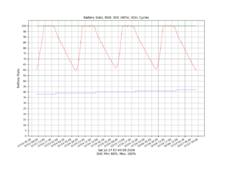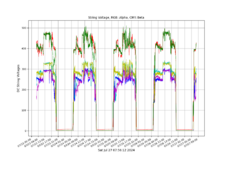kolek
Inventor of the Electron
- Joined
- Sep 29, 2021
- Messages
- 873
Posting attention people who participated in an earlier thread, and others who might have valid input.
@SeaGal @efficientPV @kmin @AntronX @sunshine_eggo @rogerdw @kommando @Mattb4 @AlaskanNoob @Hedges @Michelle Konzack @ThaiTaffy @Supervstech
Load dump management is an important topic that has been raised multiple times. In researching it, it seems the best way to make use of excess power from PV is using the methods outlined by @efficientPV and @kmin, described as follows:
"You need a controller that looks at array voltage. When array voltage goes over Vmpp, you start to divert power till the voltage drops back to Vmpp."
See related posts here and here.
Seems like few people on this forum actually have this working. @efficientPV seems to have it worked out but it's unclear what his design entails.
Does anyone on the forum have this working that could offer full details on their method? Specifically a method using Vmpp monitoring because what we want to know is when the PV array is capable of sending more power but isn't. i.e. PV generation potential exceeds the load (and the battery is already full). Having said that, if you have an SoC method working great with something like Home Assistant, open to that as well.
Please refrain from posting theoretical solutions to keep this thread on topic. This is specifically for people who have actually gotten this working in their own environment. Or if you're interested in being part of a group trying to come up with a solution to this problem please PM me. Thank you!
@SeaGal @efficientPV @kmin @AntronX @sunshine_eggo @rogerdw @kommando @Mattb4 @AlaskanNoob @Hedges @Michelle Konzack @ThaiTaffy @Supervstech
Load dump management is an important topic that has been raised multiple times. In researching it, it seems the best way to make use of excess power from PV is using the methods outlined by @efficientPV and @kmin, described as follows:
"You need a controller that looks at array voltage. When array voltage goes over Vmpp, you start to divert power till the voltage drops back to Vmpp."
See related posts here and here.
Seems like few people on this forum actually have this working. @efficientPV seems to have it worked out but it's unclear what his design entails.
Does anyone on the forum have this working that could offer full details on their method? Specifically a method using Vmpp monitoring because what we want to know is when the PV array is capable of sending more power but isn't. i.e. PV generation potential exceeds the load (and the battery is already full). Having said that, if you have an SoC method working great with something like Home Assistant, open to that as well.
Please refrain from posting theoretical solutions to keep this thread on topic. This is specifically for people who have actually gotten this working in their own environment. Or if you're interested in being part of a group trying to come up with a solution to this problem please PM me. Thank you!
Last edited:





